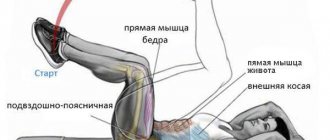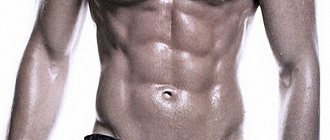Author: Timko Ilya - the ruler of the entire site and fitness trainer | more details >> Rod. 1984 Trained since 1999 Trained since 2007. Author and creator of the site tvoytrener.com. CCM in powerlifting. Champion of Russia and South Russia according to AWPC. Champion of the Krasnodar region according to IPF. 1st category in weightlifting. 2-time winner of the Krasnodar Territory championship in t/a. Author of more than 700 articles on fitness and amateur athletics. Author and co-author of 5 books.
Place in the author rating:
out of competition
(become an author) Date: 2012-05-29 Views: 952,680 Rating: 4.9
| All articles by the author >> | Medals articles >> |
Articles are loading...
| Article medals: | article in TOP 50 | more than 500 thousand views |
Why medals are given to articles:
| Bronze medal: | |
| 1. The article is in the TOP 100 2. The article has more than 3. The article has more than 100 | |
| Silver medal: | |
| 1. The article is in the TOP 50 2. The article has more than 3. The article has more than 500 | |
| Gold medal: | |
| 1. The article is in the TOP 10 2. The article has more than 1 3. The article has more than 1,000 | |
Primary muscles - iliopsoas Additional - rectus abdominis Difficulty - medium
Is it possible to pump up on the horizontal bar?
There are several points of view regarding this issue. The short answer is yes, it is possible. However, it all depends on what
what a person means by the word “pump up”.
When working out on the horizontal bar, you cannot acquire the volume of Arnold Schwarzenegger. But it is quite possible to dry out or give body relief. In addition to pull-ups, you can perform other exercises on the court that will help strengthen your abs, develop a strong grip, and pump up individual muscles. Proper preparation of a training program is the path to success.
Execution technique
Leg raises can be performed both while hanging on the horizontal bar and while hanging on the wall bars.
It doesn’t matter that you may not be able to do even one pull-up (by the way, this can be easily learned). Just grab the bar with your hands and lift your legs. You need to lift it to a direct angle to your body. But raising your legs while lying on the floor is perhaps the only exercise where you don’t have to raise your legs to a right angle. Don't try to keep your legs straight. It is necessary that your knees are slightly bent. This is done to avoid injury to the knee joints. If it is difficult for you to raise your legs straight, then raise your legs in a position where they are bent at the knees to an angle of approximately 90 degrees. Over time, when your muscles get stronger, you can gradually straighten your legs and then do the exercise with straight legs.
In the event that you cannot perform the specified number of lifts with straight legs, you can do it in any variant. That is, you perform the first approach with straight legs, even if it is only a few repetitions, and you perform the second approach with your legs bent at the knees.
And if you didn’t have enough time for the third approach, then either do as much as you can, or supplement with the exercise “Lifting legs while lying on the floor,” on a bench, on any machine on which you can perform leg lifts while lying down. Breathing is the same as when lifting your legs while lying down, that is, when lifting your legs up, you need to exhale, and when lowering, inhale.
Leg raises can be performed hanging on a wall bars or on any other machine. This can be either an inclined board or any machine designed to perform this exercise.
Sets and reps
The principle of selecting the number of approaches and repetitions in these approaches remains as follows: in the first approach, you perform such a number of repetitions as to load your muscles to 60 or 70% of their maximum capabilities.
In the second approach, perform as many repetitions as possible. Well, in the third - how it turns out. In the future, you try to gradually increase the number of repetitions in all approaches. At least one repetition in one or even several classes. Then, when your muscles are strong enough, you can use weights.
Source: https://atletizm.com.ua
Exercise technique
After jumping, you need to grab the bar.
If you cannot reach it, you should use a stand or small bench. The main thing is not to touch the floor with your feet while hanging on straight arms. Use special straps if you have a weak grip. Straighten your arms completely, bend your back slightly at the waist. Exhale. You need to hold your breath, tense your abs, and try to raise your legs as high as possible, bending them at the knees. For sufficient stress on the abs, raise your knees above your waist. At the top point, tighten your abdominal muscles as much as possible and hold in this position for 1-2 seconds. Exhale and lower your legs to the starting position, relaxing a little. After a short pause, repeat the exercise.
After fully mastering the technique, you can complicate the exercise: perform straight leg raises. At the same time, the load will increase both on the hip flexor muscles and on the lower part of the abs.
Recommendations
In order to use your abdominal muscles to their full potential, you need to raise your legs as high as possible.
Initially, the main work is performed by the hip flexor muscles, and the abdominal muscles are in isometric contraction (Tense, but the length remains the same). As soon as the hips move more than 30-45° from the vertical, the abdominal muscles contract in length and do most of the work. As this angle increases, the lower part of the rectus abdominis muscle contracts more strongly, experiencing greater load. Especially if you perform the exercise with straight legs. Under no circumstances should you swing. Lifting the legs begins from a completely motionless position. Start learning the exercise by lifting your legs, while bending them at the knees. But as you gain experience, do the exercise at a more advanced level - raise your legs while fixing the angle at your knees. Don't be embarrassed by the fact that this exercise works your hip flexors, as they are involved in all abdominal exercises. It is simply impossible to ensure that the load goes only to the abdominal muscles, without using the hip flexor muscles!
The legs in this exercise play the role of a lever, the length of which sets the level of load. To increase the load, you just need to straighten your legs more. If your quadriceps are strong enough and your hamstrings are elastic (stretch well), then to engage your abdominal muscles you will need to raise your knees much higher than your waist.
Source: https://fitmus.com
How to gain weight using a horizontal bar
For good muscle growth and weight gain when exercising on the horizontal bar, a well-known rule applies - a calorie deficit. You need to consume more than you burn during training. It is also worth including more protein and carbohydrate foods in your diet. At the same time, the consumption of baked goods and sugar should be reduced. When training, you need to drink more water, as it normalizes metabolic processes in the body.
To gain weight, you need to follow a daily routine. It is advisable to go to bed before 23.00, and it is better to devote 8-10 hours to sleep. Exercising every day is acceptable if the program involves pumping up various muscle groups
groups. In any case, for beginners it is better to exercise 3-4 times a week. At the same time, for better weight gain, short (up to an hour) but highly effective workouts should be performed. It is better to eat up to 5 times a day in small portions. The dosage interval should be 2-3 hours.
Reference.
After training, you need to replenish your energy supply as quickly as possible. You can close the “protein-carbohydrate” window with foods rich in easily digestible protein (chicken eggs, cottage cheese) and fast carbohydrates (banana with yogurt is perfect).
Execution Features
There are several ways to perform hanging leg raises. They all differ in complexity and technique. Only trained athletes can perform the classic variation of hanging leg raises to the bar. For beginners, hanging knee raises or standing leg raises are more suitable.
To perform the “Hanging Leg Raise” exercise for the press, you only need to have at hand only a horizontal bar or crossbar of a suitable height. By the way, there is probably a horizontal bar in any gym or yard sports ground. Thanks to this, this exercise is accessible to almost everyone and is very popular among athletes. For convenience, you can buy a horizontal bar for the doorway and perform hanging leg raises even at home at any suitable time.
On the subject: How to remove excess belly fat in men exercises
Muscles involved
Many beginners are interested in which muscles work when they do hanging leg raises on the horizontal bar. First of all, like all exercises for training the abdominal muscles, hanging leg raises directly engage the abdominal muscles. Namely, the rectus abdominis and external oblique muscles. In addition, at the beginning of the movement, until the moment when you raise your legs 30-45 degrees, the leg muscles also work hard. First of all, these are the long adductor and rectus femoris muscles.
Then the entire load goes directly to the abdominal muscles. At that time, the forearms receive an indirect static load. Therefore, if you want to not only pump up your abs, but also strengthen your forearms and hands, then instead of the usual abdominal crunches, do hanging leg raises on the horizontal bar.
Execution technique
Now it's time to learn the proper technique for performing traditional hanging leg raises on a horizontal bar.
The classic version of the exercise is performed primarily through the efforts of the abdominal muscles and raising the legs, slightly bent at the knees, to the level of the crossbar. It should be noted that this hanging leg raise technique is only suitable for trained athletes. Beginners should resort to more basic variations of this abdominal exercise. For example, knee raises while hanging on a bar or leg raises while standing. The technique of performing leg raises while hanging on a bar is very simple. First of all, you need to take the starting position - hanging on the bar with a straight grip slightly wider than shoulder width. Now you can start doing this exercise for the abdominal muscles. To do this, you need to use the force of the target muscles to raise your legs, slightly bent at the knees, to the level of the crossbar or at least above parallel with the floor. After going through the most difficult part of the range of motion, exhale.
Then, keeping tension in your abdominal muscles, lower your legs down while inhaling. The main task is to prevent the body from swaying while hanging on the horizontal bar and to raise not only your legs, but also lift your pelvis up, while rounding your back, as when doing abdominal crunches. This is the only way to pump up your abdominal muscles as effectively as possible.
Recommendations and common mistakes
- When performing the Hanging Leg Raise abdominal exercise, do not swing your legs back and forth to avoid inertia and dissipate the load throughout your body. Remember, if you want to pump up your abdominal muscles, you need to concentrate on working the target muscles, that is, the abdominal muscles.
- The height of the crossbar or horizontal bar should be such that your feet lightly touch or do not touch the floor at all.
- To increase the load on your abdominal muscles, try to keep your legs together during the exercise.
- At the top phase of the movement, try to lift your pelvis up, as when doing a crunch. Only in this position does contraction and development of the abdominal muscles occur most effectively.
- When performing hanging leg raises to the bar, do not try to do pull-ups or bend your elbows. Your arms should remain straight throughout the entire approach. You can move your pelvis forward slightly so that your abdominal muscles maintain constant tension.
- To get six-pack abs, perform hanging leg raises twice a week at the end of your workout. Do 3-4 sets until failure occurs due to a hellish burning sensation in the abdominal muscles.
- Leg raises while hanging on the bar are complex abdominal exercises that can be performed by trained athletes with strong core muscles. Therefore, as a rule, leg lifts are performed without additional weights. However, if you were able to easily complete 3-4 sets of 20 repetitions, then you can use special leg weights as additional weight. This will allow you to further increase the workload on your abdominal muscles.
- If you have a weak grip, use special wrist straps or perform leg raises on a machine.
Source: https://fit4gym.ru
A little about the correct technique
What muscles are in pull-ups on the horizontal bar?
more involved? There are quite a lot of them - the latissimus muscles, lower trapezius, biceps, triceps, forearm muscles and several other small muscles. Improper execution of the exercise not only reduces effectiveness, but also increases the risk of injury. The first point is breathing. Hanging in a free state, you should take air into your chest. When pulling the latissimus dorsi muscles, you should exhale smoothly. When lowering down, you should inhale again. Effort – exhale, relaxation – inhale. Thus, lowering down is one repetition.
The legs are an important part of the pull-up. Jerking and dangling are not allowed. When performing pull-ups on a wall bar, you should cross your legs for comfort. If there is enough space, then ideally they should be straightened. When moving up, the whole body is tense
. This way you prevent swaying and increase the effectiveness of the exercise.
You should not make sudden movements when doing pull-ups and try to somehow lift your chin over the bar on the last repetition. Do not twist your whole body, if your arms are still holding, then perform an incomplete pull-up
in strict technique. This way you can achieve a better response from the back muscles.
Clue.
To increase pull-ups, you can use the “Vietnamese style”.
It involves resting after the approach, hanging on each arm
.
This will allow you to add a few more repetitions. But in order to use it efficiently, you need to have a strong grip
and well-developed forearms.
HANGING LEG RAISES WITH WEIGHTS
Working muscles
The main ones are the rectus abdominis muscles, which are loaded more than in previous exercises. For this reason, this type of leg lift is not recommended for girls. The iliopsoas and thigh muscles are also involved.
Step-by-step instruction
Step 1. Secure yourself onto the bar with an overhand grip, hands shoulder-width apart.
Step 2: Have a partner or trainer hand you a weight to hold between your feet.
Step 3. Inhale, tighten your abs, and as you exhale, lift your legs to your chest as high as possible.
Step 4: Pause at the top position and tighten your abdominal muscles even more.
Step 5: Slowly lower your legs.
Step 6. Do the required number of repetitions.
Tips for implementation
- To avoid swinging, ask a coach or partner to fix their palm on your lower back.
- When lifting, do not rest your chin on your chest, look ahead.
- If you want to engage your obliques, bend your legs toward the opposite shoulder in an incline.
- A more advanced level is to raise straight legs.
Mass training program
Several types of pull-ups should be included in your weight training program. Muscles work in each of them
differently. Thanks to this, you can get not only a wide back, but also pumped up arms.
Wide grip pull-ups
Allows the latissimus dorsi muscles to be more involved in the work. To start pulling up
, you need to place your hands wider than
your shoulders
, straight grip. When pulling up, the elbows go to the sides.
Close-grip pull-ups
There are some differences here. Hands are placed with a narrow grip, fingers pointing back. Narrow overhand grip
designed for pumping biceps. To isolate the muscle, it is worth rounding your back, thereby relieving some of the load from the latissimus muscles. When performing the exercise, you should not fully extend your elbows, as in other grips. This is necessary so that the biceps are in tension all the time.
Parallel grip pull-ups
To perform these pull-ups you will need a handle bar. This exercise can be done on the parallel bars with your legs tucked. When doing pull-ups, your head should move freely over the bar. In addition to the back muscles, they allow you to work the brachialis and forearm muscles.
How to combine exercises for muscle growth
It is better to combine the listed exercises with others. In addition, wide-grip pull-ups should be done during training aimed specifically at developing the back.
BENT LEEG RAISES HANGING ON A BAR
Working muscles
As in the previous exercise, when lifting with bent legs, the main load falls on the rectus and oblique abdominal muscles. Additionally, the rectus femoris and iliopsoas muscles are involved. The shoulder blades, shoulder joints and abdominal muscles act as stabilizers.
Step-by-step instruction
Step 1. Grab the bar with your hands using a wide or medium grip.
Step 2. Fix in a position with straight arms and legs, a slightly bent back at the waist.
Step 3. First, inhale deeply, and then as you exhale, pull your legs towards your chest as high as possible.
Step 4. Hold this position for a second and tighten your abdominal muscles.
Step 5. Slowly lower your legs and return to the starting position.
Step 6. Do the required number of repetitions.
Tips for implementation
During the exercise it is very important not to sway. If you have trouble maintaining your balance on the bar, have someone hold their hand on your lower back. The easiest way to avoid swinging is to do the exercise on the top bar of a wall bar.
If you experience pain in the lumbar region, try spreading your toes apart and bringing your heels as close as possible.
Recommendations and tips
Let's list the basic tips and tricks that will help you gain muscle mass faster.
- Increase your daily caloric intake.
- If your muscles are tight or sore, take an extra day of rest.
- Don't focus on quantity, focus on quality.
- Don't forget about the progression of loads.
- If it gets too easy, use weights.
Choice of weights
When the number of pull-ups performed has exceeded 15, it makes sense to include weights in your training. This will allow you to better work out your back muscles, which have already adapted to the usual load of your own body weight.
Regular backpack
For the initial stage of working with weights, a regular backpack is suitable, in which you can put dumbbells or place a bottle of water. The optimal weight of such homemade “equipment” is no more than 6 kg. A heavier backpack will pull you back, causing discomfort and disrupting your technique, which can lead to injury.
Weighted belt or vest
A belt for additional weights is a device that is fixed on a belt, which has a mount for hanging free weights. You can attach both weights and weights to it.
A more advanced and expensive option is a weighted vest. It allows the extra weight to be evenly distributed throughout the body. The weight used can be customized by removing or adding weights from the vest compartments.
Lying leg raises
Lying leg raises are a very popular exercise for the lower abdomen. However, if you do this exercise not in a reduced amplitude, but in full, then it perfectly develops the abdominal muscles along the entire length, including its upper part. This exercise is good to do with a partner. Lie with your back on the floor. partner behind you. Grasp your partner's ankles with your hands. Raise your legs to a vertical position. When the legs are at the top, the partner must forcefully push them forward. Your task is to resist the free fall of the legs, i.e. Don't let them touch the floor.
Weight gain strategy
To get the expected effect from working with weights, you need to adhere to a certain strategy.
She looks like this.
- Only start lifting weights when you can do 15 quality pull-ups.
- In the first two weeks, use 5 kg. After you've finished lifting the weights, do 2 more sets of maximums with your own body weight. This will allow the muscles to be hammered as much as possible.
- Next, it is advisable to increase the weight by 1 or 2.5 kg. However, know that if increasing becomes too difficult, back off to the previous value. Do this until the muscles are ready for new growth.
- It will be best to add weight when, with the previous weighting, you can do the same amount with which you started (15 times, for example). This will be relevant in the first stages.
TECHNIQUE
Using the strength of your abdominal muscles, lift your slightly bent legs up so that your toes are at chest level, only after overcoming
parallel to the floor, when the hips rise above their axis, the abs really begin to work. Gently lower your legs down, holding them at a slight angle to contract your abdominal muscles, and lift them up again. When the muscles contract upward, we exhale; when the muscles relax downward, we inhale.
Problems of horizontal bar lovers
Horizontal bar lovers
sometimes they face unpleasant problems.
Moreover, some of them can be caused even by ordinary pull-ups on the bar
. Let's take a closer look at the main disadvantages that come with exercising on outdoor sports equipment.
Injuries
Injuries usually plague beginners who do not understand the technique and neglect warming up. It is very important, as it helps to warm up the joints and ligaments and set them up for work. Before training, it is necessary to use dynamic stretching (swings, circular movements), and after training, static stretching (holds) in order to stretch the heated ligaments and avoid the feeling of “woodiness”.
The list of injuries sustained on the horizontal bar includes bruises, sprains and joint damage. They are not very dangerous, but it is better to prevent them than to be taken out of the training process for several days.
Calluses
Not everyone likes to train in gloves - because sometimes they slip and reduce grip strength. That's why people often get calluses on the horizontal bars - an unpleasant thing that sometimes hurts for several days. In addition, if the callus contains blood, it must be disinfected to prevent infection.
To reduce calluses, you can use magnesium, which provides grip by preventing unnecessary friction between your palm and the bar.
To combat calluses, you need to take measures. Old and dried formations can be cut off with a razor. At night, it is advisable to smear your palms with moisturizer. Holding your palms in warm water also helps; it steams dry skin, which can be carefully cut off.
Ligament pain
Typically, pain in the ligaments is the result of a poor warm-up, poor technique, or overtraining. After all, during rest, not only muscles are restored, but also ligaments are strengthened.
To reduce pain and prevent its occurrence, we recommend using wristbands and elbow braces. They fix the hand and elbow (the most common places for problematic ligaments), warm them and prevent injury. If there was a sprain, applying tape to the affected areas will help.
Falls from the horizontal bar
Falls from the crossbar do happen. Usually due to carelessness or rash actions, although no one is immune from accidents. However, falls are only possible when performing various types of elements. Basic pull-ups can't cause you to fall.
In our article, we revealed all the aspects of performing correct pull-ups, learned how you can gain weight on the horizontal bar, and looked at possible injuries and problems that arise when exercising on the horizontal bars.
Share link:
Week schedule
You need to start training with a minimum load, perform as many repetitions as you can until you feel tired in the lower abdomen. You shouldn’t rush into battle right away; it’s better to slowly increase the number of approaches. After just a couple of weeks of regular training, which should be at least 3 per week, you will be able to perform 15 lifts in 3-4 approaches.
The break between approaches is no more than 2 minutes. If the athlete was able to complete 5 or more pull-ups, then you can begin a more intense workout. There must be at least 3 lessons per week, each lasting 1 hour.
Approximately the training should consist of the following program:
| Name | approaches |
| "jumping" pull-ups | 3 approaches, each with 10-15 exercises |
| straight leg pull-up | 3 sets of 10 exercises |
| horizontal pull-up on the bar | 3-4 approaches, each up to 12 exercises |
| alternate leg pull-ups | 3 sets of 10 exercises |
| French press on a low bar | 4 sets of 10 exercises |
| leg lift with ball | 3 sets of 10 exercises |
| reverse grip pull-up | 3 sets of 10 exercises |
| raising your legs to the bar itself | 3 sets of 10 exercises |
Horizontal pull-up on the bar.
This is an approximate workout plan for 1 hour. You can change the exercises periodically, but you don’t need to reduce the load; on the contrary, you should increase it each time. You can add approaches.











